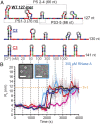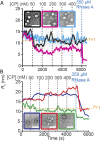Rewriting nature's assembly manual for a ssRNA virus
- PMID: 29087310
- PMCID: PMC5699041
- DOI: 10.1073/pnas.1706951114
Rewriting nature's assembly manual for a ssRNA virus
Abstract
Satellite tobacco necrosis virus (STNV) is one of the smallest viruses known. Its genome encodes only its coat protein (CP) subunit, relying on the polymerase of its helper virus TNV for replication. The genome has been shown to contain a cryptic set of dispersed assembly signals in the form of stem-loops that each present a minimal CP-binding motif AXXA in the loops. The genomic fragment encompassing nucleotides 1-127 is predicted to contain five such packaging signals (PSs). We have used mutagenesis to determine the critical assembly features in this region. These include the CP-binding motif, the relative placement of PS stem-loops, their number, and their folding propensity. CP binding has an electrostatic contribution, but assembly nucleation is dominated by the recognition of the folded PSs in the RNA fragment. Mutation to remove all AXXA motifs in PSs throughout the genome yields an RNA that is unable to assemble efficiently. In contrast, when a synthetic 127-nt fragment encompassing improved PSs is swapped onto the RNA otherwise lacking CP recognition motifs, assembly is partially restored, although the virus-like particles created are incomplete, implying that PSs outside this region are required for correct assembly. Swapping this improved region into the wild-type STNV1 sequence results in a better assembly substrate than the viral RNA, producing complete capsids and outcompeting the wild-type genome in head-to-head competition. These data confirm details of the PS-mediated assembly mechanism for STNV and identify an efficient approach for production of stable virus-like particles encapsidating nonnative RNAs or other cargoes.
Keywords: packaging signals; satellite tobacco necrosis virus; synthetic virology; viral assembly.
Copyright © 2017 the Author(s). Published by PNAS.
Conflict of interest statement
The authors declare no conflict of interest.
Figures





Similar articles
-
Investigating the Biological Relevance of In Vitro-Identified Putative Packaging Signals at the 5' Terminus of Satellite Tobacco Necrosis Virus 1 Genomic RNA.J Virol. 2019 Apr 17;93(9):e02106-18. doi: 10.1128/JVI.02106-18. Print 2019 May 1. J Virol. 2019. PMID: 30814279 Free PMC article.
-
Degenerate RNA packaging signals in the genome of Satellite Tobacco Necrosis Virus: implications for the assembly of a T=1 capsid.J Mol Biol. 2011 Oct 14;413(1):51-65. doi: 10.1016/j.jmb.2011.07.063. Epub 2011 Aug 3. J Mol Biol. 2011. PMID: 21839093
-
Visualizing Viral RNA Packaging Signals in Action.J Mol Biol. 2024 Nov 15;436(22):168765. doi: 10.1016/j.jmb.2024.168765. Epub 2024 Aug 29. J Mol Biol. 2024. PMID: 39214281
-
A modelling paradigm for RNA virus assembly.Curr Opin Virol. 2018 Aug;31:74-81. doi: 10.1016/j.coviro.2018.07.003. Epub 2018 Aug 2. Curr Opin Virol. 2018. PMID: 30078702 Free PMC article. Review.
-
3D Puzzle at the Nanoscale-How do RNA Viruses Self-Assemble their Capsids into Perfectly Ordered Structures.Macromol Biosci. 2024 Sep;24(9):e2400088. doi: 10.1002/mabi.202400088. Epub 2024 Jun 24. Macromol Biosci. 2024. PMID: 38864315 Review.
Cited by
-
Therapeutic interfering particles exploiting viral replication and assembly mechanisms show promising performance: a modelling study.Sci Rep. 2021 Dec 13;11(1):23847. doi: 10.1038/s41598-021-03168-0. Sci Rep. 2021. PMID: 34903795 Free PMC article.
-
Laboratory evolution of virus-like nucleocapsids from nonviral protein cages.Proc Natl Acad Sci U S A. 2018 May 22;115(21):5432-5437. doi: 10.1073/pnas.1800527115. Epub 2018 May 7. Proc Natl Acad Sci U S A. 2018. PMID: 29735682 Free PMC article.
-
Stimulus-responsive assembly of nonviral nucleocapsids.Nat Commun. 2024 Apr 27;15(1):3576. doi: 10.1038/s41467-024-47808-1. Nat Commun. 2024. PMID: 38678040 Free PMC article.
-
Molecular interactions of plant viral satellites.Virus Genes. 2021 Feb;57(1):1-22. doi: 10.1007/s11262-020-01806-9. Epub 2020 Nov 23. Virus Genes. 2021. PMID: 33226576 Review.
-
RNA Virus Evolution via a Quasispecies-Based Model Reveals a Drug Target with a High Barrier to Resistance.Viruses. 2017 Nov 17;9(11):347. doi: 10.3390/v9110347. Viruses. 2017. PMID: 29149077 Free PMC article.
References
-
- Prevelige PE., Jr Follow the yellow brick road: A paradigm shift in virus assembly. J Mol Biol. 2016;428:416–418. - PubMed
-
- Rudnick J, Bruinsma R. Icosahedral packing of RNA viral genomes. Phys Rev Lett. 2005;94:038101. - PubMed
-
- van der Schoot P, Bruinsma R. Electrostatics and the assembly of an RNA virus. Phys Rev E Stat Nonlin Soft Matter Phys. 2005;71:061928. - PubMed
Publication types
MeSH terms
Substances
Grants and funding
- 110145/Z/15/Z/WT_/Wellcome Trust/United Kingdom
- BB/J00667X/1/BB_/Biotechnology and Biological Sciences Research Council/United Kingdom
- 10146/WT_/Wellcome Trust/United Kingdom
- 110145/WT_/Wellcome Trust/United Kingdom
- BB/L022095/1/BB_/Biotechnology and Biological Sciences Research Council/United Kingdom
LinkOut - more resources
Full Text Sources
Other Literature Sources
Research Materials
Miscellaneous

